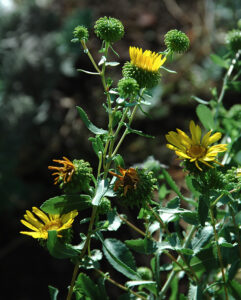BY HARRY WEEKES

In the middle of August, I decided to meet my neighbors. Armed with a cookie and my phone, I started down the driveway. I should probably stop here and expand.
I was holding a cookie (singular), which was rapidly becoming no cookie, as I took my evening cookie walk. I was carrying my phone because I was hoping to capture the call of the Common Poorwill, a bird that lives in the sage hills around my house. As I walked, a whole slew of insects flitted about, amongst them a Skipper (which now, according to recent taxonomic shuffling, are grouped with the butterflies). “Ooooh,” I thought, “a perfect chance to use my Seek App.” Seek is an app developed by National Geographic and the California Academy of Sciences that helps identify species from pictures of them.
There I was, partial cookie in hand, working to close the gap on a camera-shy Skipper, when I accidentally identified a plant (when the Skipper flew off, the plant it was perched on came into focus, and the Seek App started identifying it).
I stood up, looked around, and realized, for the 100th time in my life, how little I know about plants. My walk down the driveway turned into a zigzagging creep from one unknown species to another. The cookie ran out long before the new plants, and by the time I got to my turnaround point (about a quarter of a mile), I had added 18 species to my list, earned myself a Bronze Plant Badge, and moved up to ‘Surveyor Level’ in the app. Rather than accomplishments, these latter were implications of the obvious — how few plants I have even tried to record in the app.
Immediately, a whole new world came to life, filled with fantastic characters like Smooth Brome. Willow Dock. Yellow Salsify.
The various groupings spawned a variety of questions. Cataloguing Sulfur Buckwheat, Parsnipflower, Great Basin Wildrye, Chokecherry and Golden Currant made me ask, “Are all of these edible?”
Something about Yarrow, Silver Wormwood, and Common Lambsquarters made me wonder, “Are these medicinal? If so, what would they be used for?”
And Leafy Fleabane and Pitcher’s Thistle brought images of witches and warlocks crumbling dried leaves into steaming pots.
Ultimately, this small bouquet of plants amounted to eight different families with their attendant complicated Latin names (Grossulariaceae, Polygonaceae, Scrophulariaceae) joined to more playful common names (Gooseberry, Knotweed, Figwort). As each plant was occupying some small stretch of the side of the road, I never even ventured off the driveway, and spent only a brief moment thinking about how many plants had long since flowered and vanished from the late summer landscape.
In other words, I only met a sliver of my neighbors, and it was the briefest of introductions.
What magic is held in these plants? What would they tell me if I knew more about their lives? About where and how they grow? About what insects they repel and what nutrients they need? I am certain they could tell me where pockets of minerals lie in the ground, or help me get rid of a sunburn, or offer a small snack, or a tangy spice.
Meeting someone starts with a simple introduction. Getting to know them is about spending time with them, asking questions, and being curious. I look forward to this new conversation. A conversation with plants I have known—Mullein, Prairie Sunflower, Cottonwood—and those whose names create a starburst of imaginative associations.
Look for me on the road, cookie in my hand, talking to my new sidekick, Curlycup Gumweed.
Harry Weekes is the founder and head of school at The Sage School in Hailey. This is his 50th year in the Wood River Valley, where he lives with Hilary and one of their three baby adults – Simon. The other members of the flock, Georgia and Penelope, are currently fledging at Davidson College in North Carolina and Middlebury College in Vermont, respectively.


